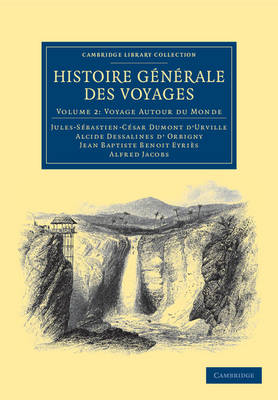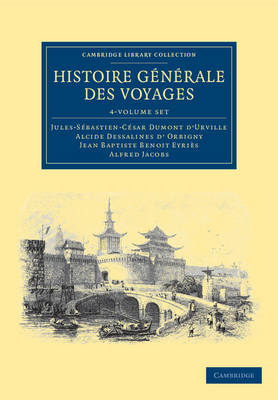Cambridge Library Collection - Maritime Exploration
1 primary work • 6 total works
Volume 2
This four-volume collection was issued by the Paris publisher Furne in the mid-nineteenth century to showcase the adventures and discoveries of recent French explorers. In Volumes 1 and 2 the naval officer Jules Dumont d'Urville (1790–1842) presents a lightly fictionalised account based on his first two voyages to the Pacific on board the Coquille (renamed L'Astrolabe for the second voyage). This was intended for a wider audience and offered at a more affordable price than the large-format scientific expedition reports produced for the French government. The work, illustrated with engravings, was originally published in 1832, but the printings by Furne reissued here date from 1863 and 1859 respectively. Volume 2 describes the voyage from French Polynesia back to France via Australia, New Zealand and Cape Horn. It includes d'Urville's discovery of the location in the Solomon Islands where the explorer Jean-Francois La Pérouse's ships had mysteriously disappeared in 1788.
This four-volume, illustrated collection, issued by the Paris publisher Furne in the mid-nineteenth century, showcased the work of recent French explorers for a popular readership avid for accounts of exotic foreign lands. It contains lightly fictionalised versions of accounts by three influential geographers and naturalists. Volumes 1 and 2, by the naval officer Jules Dumont d'Urville (1790-1842), cover his first two voyages to the Pacific; originally published in 1832, the printings reissued here date from 1863 and 1859. Volume 3 contains an account by Alcide d'Orbigny (1802-57) of his travels in South America in 1826-33, supplemented by material on North America and Iceland. It was first published in 1841; this posthumous 1859 printing was updated by Alfred Jacobs (1802-70). Volume 4 (1859), substantially updated by Jacobs, is based on an 1839 publication by Jean-Baptiste Benoit Eyries (1767-1846), a founder member of the French Geographical Society.
This four-volume collection was issued by the Paris publisher Furne in the mid-nineteenth century to showcase the work of recent French explorers for a readership avid for accounts of exotic foreign lands. Volume 3 is an updated version of an 1841 publication by the influential French palaeontologist Alcide d'Orbigny (1802-57), who between 1826 and 1833 travelled around South America collecting natural history specimens for the Paris Museum. The scientific publications resulting from this fieldwork were greatly admired by Charles Darwin. This lightly fictionalised account of d'Orbigny's travels, illustrated with engravings, was supplemented by information on North America derived from other sources. It went through several editions; this posthumous 1859 printing was further expanded by Alfred Jacobs (1827-62). It begins by describing the Caribbean, focuses in detail on South America, and continues with accounts of the history, landscapes and peoples of Mexico, the United States, Canada, Greenland and Iceland.
This four-volume collection was issued by the Paris publisher Furne in the mid-nineteenth century to showcase the adventures and discoveries of recent French explorers. In Volumes 1 and 2 the naval officer Jules Dumont d'Urville (1790-1842) presents a lightly fictionalised account based on his first two voyages to the Pacific on board the Coquille (renamed L'Astrolabe for the second voyage). This was intended for a wider audience and offered at a more affordable price than the large-format scientific expedition reports produced for the French government. The work, illustrated with engravings, was originally published in 1832, but the printings by Furne reissued here date from 1863 and 1859 respectively. Volume 1 describes the voyage through the Atlantic to the Cape of Good Hope, and focuses on South and South-East Asia, China and Hawaii, covering natural history, indigenous culture, and colonial commerce. It ends with the ship's arrival in French Polynesia.
Histoire generale des voyages par Dumont D'Urville, D'Orbigny, Eyries et A. Jacobs: Volume 4, Voyage en Asie et en Afrique d'apres les recits des derniers voyageurs
by Jules Sebastien Cesar Dumont d'Urville, Alcide Dessalines D'Orbigny, Jean Baptiste Benoit Eyries, and Alfred Jacobs
Published 5 November 2015
This four-volume collection was issued by the Paris publisher Furne in the mid-nineteenth century to showcase the work of recent French explorers for a readership avid for accounts of exotic foreign lands. Volume 4 was prepared by Alfred Jacobs (1802-62), an archivist and palaeographer, drawing heavily on an 1839 publication by Jean-Baptiste Benoit Eyries (1767-1846). Eyries was a founder member of the French Geographical Society and a member of the Asiatic Society, trained in botany and mineralogy, an accomplished linguist and seasoned traveller, who wrote, edited and translated a substantial number of works on geography, travel and exploration. Like earlier volumes in Furne's collection, this account of Asia and Africa takes the form of a fictionalised journey, making use of a wide range of additional sources to give readers as complete a picture as possible. This 1859 edition is illustrated with twenty-two engravings.
This four-volume collection was issued by the Paris publisher Furne in the mid-nineteenth century to showcase the adventures and discoveries of recent French explorers. In Volumes 1 and 2 the naval officer Jules Dumont d'Urville (1790-1842) presents a lightly fictionalised account based on his first two voyages to the Pacific on board the Coquille (renamed L'Astrolabe for the second voyage). This was intended for a wider audience and offered at a more affordable price than the large-format scientific expedition reports produced for the French government. The work, illustrated with engravings, was originally published in 1832, but the printings by Furne reissued here date from 1863 and 1859 respectively. Volume 2 describes the voyage from French Polynesia back to France via Australia, New Zealand and Cape Horn. It includes d'Urville's discovery of the location in the Solomon Islands where the explorer Jean-Francois La Perouse's ships had mysteriously disappeared in 1788.


